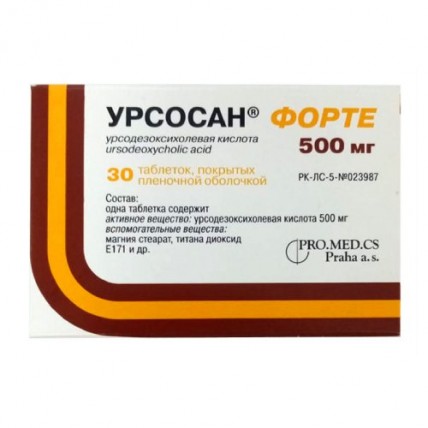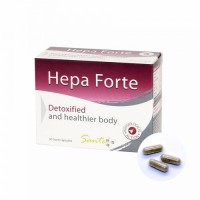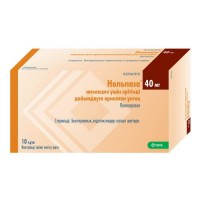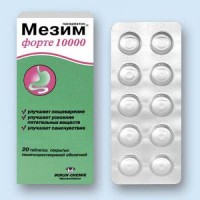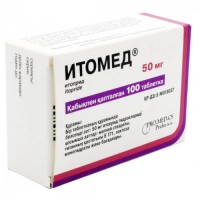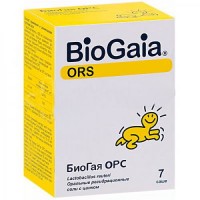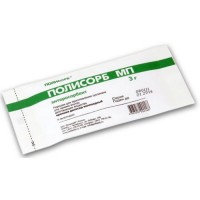URSOSAN® FORTE (Ursodiol) 500 mg, 30 film-coated tablets
- $60.00
One tablet contains
With oral administration of ursodeoxycholic acid (UDCA), rapid complete absorption occurs in the small intestine due to passive diffusion, and in the ileum through active transport. The absorption rate is typically 60 - 80%. UDCA is 96 - 98% bound to plasma proteins, is effectively released in the liver and excreted in the bile in the form of glycine and taurine conjugates. In the intestine, some of the conjugates are deconjugated and reabsorption occurs.
Conjugates can also be dehydroxylated to lithocholic acid, some of which is absorbed, sulfated in the liver and excreted through the biliary tract. When taken systematically, ursodeoxycholic acid becomes the main bile acid in the blood serum (48% of the total content of bile acids), which leads to a decrease in the absorption of toxic bile acids and their entry into the liver. The therapeutic effect of the drug depends on the concentration of UDCA in bile. The biological half-life of ursodeoxycholic acid is 3-5, 5-8 days.
Ursodeoxycholic acid (UDCA) is a bile acid and is naturally produced in the human body in small amounts (no more than 5%). Reduces the synthesis of cholesterol in the liver and the concentration of cholesterol in bile, increases the solubility of cholesterol in the biliary system, stimulates the formation and excretion of bile. UDCA reduces the saturation of bile with cholesterol by inhibiting its absorption in the intestine, primarily due to the dispersion of cholesterol and the formation of a liquid crystalline phase, and reduces the lithogenic index of bile. The result is the dissolution of cholesterol gallstones and the prevention of the formation of new stones.
Possessing high polar properties, UDCA forms non-toxic mixed micelles with apolar (toxic) bile acids, which reduces the ability of gastric reflux to damage cell membranes in cholestatic liver diseases, biliary reflux gastritis and reflux esophagitis. In addition, UDCA forms double molecules that can be included in the cell membranes of hepatocytes, cholangiocytes and epithelial cells of the gastrointestinal tract, stabilizes and protects them from the damaging effects of toxic bile acids. By reducing the concentration of toxic bile acids and stimulating bicarbonate-rich choleresis, UDCA is effective in resolving intrahepatic cholestasis. Competitively reduces the absorption of lipophilic bile acids in the intestine, increases their "fractional" turnover during enterohepatic circulation, induces choleresis, stimulates the passage of bile and the excretion of toxic bile acids through the intestines. Causes increased gastric and pancreatic secretion, increases the activity of lipase, has a hypoglycemic effect.
The immunomodulatory effect is due to the inhibition of the expression of HLA antigens on the membranes of hepatocytes and cholangiocytes, the normalization of the natural killer activity of lymphocytes, the formation of interleukin-2, a decrease in the number of eosinophils, the suppression of immunocompetent immunoglobulins (Ig), primarily IgM; regulation of apoptosis of hepatocytes and epithelial cells of the gastrointestinal tract. Significantly delays the progression of fibrosis in patients with primary biliary cirrhosis, cystic fibrosis, alcoholic and non-alcoholic steatohepatitis, reduces the risk of developing esophageal varicose veins.
Cystic fibrosis - pediatric population. Long-term experience is available in the treatment of pediatric patients with cystic fibrosis associated with
hepatobiliary diseases (CFAND) with the use of UDCA, up to 10 years or more. There is evidence that UDCA therapy can reduce bile duct proliferation, halt the progression of histological changes, and even reverse hepatobiliary changes early in CFAHD. UDCA therapy should be initiated as soon as possible after the diagnosis of CFAND is made to optimize treatment efficacy.
- Dissolution of cholesterol gallstones in the gallbladder. Gallstones should not appear as shadows on x-rays and should not exceed 15 mm in diameter. The functional capacity of the gallbladder must be preserved even in the presence of gallstones.
- Symptomatic treatment of primary biliary cholangitis (PBC) in the absence of decompensated liver cirrhosis.
Child population
- Hepatobiliary disorder in cystic fibrosis (cystic fibrosis) in children aged 6 to 18 years.
URSOSAN® FORTE tablets should be taken orally during or after meals, without chewing, drinking plenty of water. To ensure the recommended dosage, the tablet should be divided in half, breaking at risk. Segments broken incorrectly should not be used. When holding the segment in the oral cavity, a bitter taste is felt. URSOSAN® FORTE has no age restrictions in use, however, children under 6 years of age are not recommended to use the drug in this dosage form.
Apply regularly. Calculation of the daily number of tablets depending on the patient's body weight and the recommended dose of the drug per 1 kg of body weight, mg / kg / day
To dissolve cholesterol gallstones, the average daily dose of the drug is 10 mg / kg (up to 12-15 mg / kg).
The daily dose of the drug is taken once at night. The course of treatment is from 6 to 24 months, depending on the size and composition of the gallstones. A follow-up cholecystogram or ultrasound is recommended at 6-month intervals until the gallstones have disappeared and should be checked for calcification of the stones.
Treatment should be continued until 2 consecutive cholecystograms and/or ultrasound scans 4-12 weeks apart show no gallstones. If gallstones do not decrease in size after 12 months of treatment, the drug should be discontinued. To prevent the recurrence of stones, it is recommended to use the drug for several months after the dissolution of the stones.
For the prevention of recurrent cholelithiasis after cholecystectomy, 250 mg (½ tablet) is prescribed 2 times a day for several months.
Symptomatic treatment of primary biliary cholangitis (PBC)
The daily dose depends on body weight and ranges from 1 ½ to 3 ½ tablets (14 ± 2 mg UDCA per 1 kg of body weight).
During the first three months of treatment, URSOSAN® FORTE tablets should be distributed throughout the day. If liver function tests improve, the daily dose can be taken once a day in the evening.
With PBC, URSOSAN® FORTE tablets can be taken for an unlimited period of time.
In case of worsening of clinical symptoms at the beginning of treatment (increased itching), treatment should be continued, taking ½ tablet URSOSAN® FORTE daily, then the dosage should be gradually increased (increasing the daily dose weekly by ½ tablet) until the recommended regimen is reached again. dosing.
Children population (6-18 years old)
Hepatobiliary disorder in cystic fibrosis (cystic fibrosis)
Children with cystic fibrosis aged 6 to 18 years: 20 mg/kg/day in 2-3 divided doses, increasing further to 30 mg/kg/day as needed.
The frequency of occurrence of side effects (number of cases / number of observations) is presented as the following gradation: very often (≥1/10); often (≥1/100 to <1/10); infrequently (≥1/1000 to <1/100); rarely (≥1/10000 to <1/1000); very rare (<1/10,000), unknown - the frequency cannot be calculated from the available data.
From the gastrointestinal tract
In clinical studies, during treatment with URSOSAN® FORTE tablets , diarrhea or pasty stools were often observed.
In the treatment of primary biliary cirrhosis , severe pain in the upper abdomen was very rarely noted.
From the side of the liver and biliary tract
During treatment with URSOSAN® FORTE tablets , calcification of gallstones was observed in very rare cases.
In the treatment of primary biliary cirrhosis in the later stages , in very rare cases, decompensation of liver cirrhosis was noted, which regressed after discontinuation of treatment.
From the skin and subcutaneous tissues
In very rare cases , urticaria may occur.
- hypersensitivity to bile acids or any excipient that is part of the drug
- acute inflammatory diseases of the gallbladder or bile ducts
- obstruction of the bile ducts (obstruction of the common bile duct or cystic bile duct)
- frequent bouts of biliary colic
- radiopaque calcified gallstones
- impaired contractility of the gallbladder
- children's age up to 6 years
Child population
- portoenterostomy that has not been successful or if sufficient bile duct has not been restored in children with bile duct atresia
URSOSAN FORTE should not be administered concomitantly with cholestyramine, cholestipol or antacids containing aluminum hydroxide and/or smectite (aluminum oxide), as these drugs bind UDCA in the intestine and therefore inhibit its absorption and effectiveness. These drugs should be taken no earlier than 2 hours before or 2 hours after taking URSOSAN® FORTE tablets.
Taking URSOSAN® FORTE tablets may affect the absorption of cyclosporine from the intestine, which requires monitoring of the concentration of cyclosporine in the blood plasma, and, if necessary, correction of its dosing regimen.
In some cases, taking URSOSAN® FORTE tablets may reduce the absorption of ciprofloxacin.
Simultaneous use of URSOSAN® FORTE (500 mg/day) and rosuvastatin (20 mg/day) resulted in a slight increase in the presence of rosuvastatin in plasma. The clinical relevance of this interaction, including for other statins, is unknown.
There is evidence that UDCA reduces the peak plasma concentration (Cmax) and the area under the pharmacokinetic curve (AUC) of the calcium antagonist nitrendipine, which requires monitoring of the concentration of nitrendipine. The need to increase the dose of nitrendipine is not excluded. There is evidence that the interaction of UDCA and dapsone leads to a decrease in the effect of the latter.
These observations may indicate the potential of UDCA to induce cytochrome P450 3A enzymes. However, induction was not observed in a careful study of the interaction of UDCA with budesonide, known as the cytochrome substrate P450 3A.
Some drugs, such as estrogens, progestogens (oral contraceptives), neomycin, clofibrate, can increase cholelithiasis, thereby having the opposite effect of the ability of ursodeoxycholic acid to dissolve cholesterol gallstones.
URSOSAN® FORTE tablets should be taken under medical supervision.
During the first three months of treatment, the physician should check liver function tests for AST (SGOT), ALT (SGPT), and GGT (y-GT) every 4 weeks and every 3 months thereafter. While this will allow for the identification of responders and non-responders in the treatment population, it will also allow early identification of potential liver damage, especially in patients with advanced primary biliary cholangitis. When used to dissolve cholesterol gallstones:
In order to assess the progress of treatment, as well as to timely detect any calcification of gallstones, depending on the size of the stone, it is necessary to visualize the gallbladder (oral cholecystography) - general view and occlusion in the standing and supine position (check with ultrasound) later 6-10 months after the start of treatment.
If the gallbladder cannot be visualized on an x-ray or if there are calcified gallstones, impaired contractility of the gallbladder or frequent episodes of biliary colic, URSOSAN® FORTE should not be used.
When used to treat advanced stage primary biliary cholangitis. In very rare cases, decompensation of liver cirrhosis has been observed with partial regression after discontinuation of treatment.
In patients with PBC, in rare cases, at the beginning of treatment, there may be a worsening of clinical symptoms, i.e. itching may worsen. In this case, the dosage should be reduced to 250 mg per day and gradually increased to the recommended dose indicated in the "Dosage and Administration" section.
In case of diarrhea, the dose should be reduced, and in cases of persistent diarrhea, treatment should be discontinued.
Additional information for special patient groups
Long-term therapy with high doses of URSOSAN® FORTE (28 - 30 mg/kg/day) in patients with primary sclerotizing cholangitis (off-label use) was associated with a higher incidence of adverse severe drug reactions. Pregnancy and lactation
There are no data on the effect on fertility after treatment with URSOSAN® FORTE tablets. There are no or limited data on the use of ursodeoxycholic acid in pregnant patients. There is evidence of a teratogenic effect during the early phase of pregnancy. The use of UDCA during pregnancy is possible only if the expected benefit to the mother outweighs the potential risk of side effects in the fetus or newborn (adequate and well-controlled studies of the use of ursodeoxycholic acid in pregnant women have not been conducted). Women of childbearing age should take the drug only while using reliable contraceptives.
It is recommended to use non-hormonal methods of contraception, or low estrogen. In patients taking URSOSAN® FORTE 500 mg tablets to dissolve gallstones, non-hormonal methods of contraception should be used, since hormonal contraceptives can promote the formation of stones. The possibility of pregnancy must be ruled out before starting treatment.
According to several confirmed cases, the concentration of ursodeoxycholic acid in the milk of lactating women is low; the occurrence of adverse reactions in children during breastfeeding is unlikely. Features of the influence of the drug on the ability to drive a vehicle or potentially dangerous mechanisms
Does not affect.
Symptoms : diarrhea. In this case, it is necessary to reduce the dose, and if diarrhea (diarrhea) does not disappear, stop the treatment. Other overdose symptoms are unlikely as the absorption of ursodeoxycholic acid decreases with increasing dose and therefore more is excreted in the feces.
Treatment: symptomatic with compensation for loss of fluid volume and electrolyte balance.
In original packaging at a temperature not exceeding 25°C.
Keep out of the reach of children!
Shelf life - 4 years
Do not use after the expiration date.
- Active ingredients: o - ursodeoxycholic acid 500 mg
- Excipients (core): corn starch, pregelatinized corn starch, sodium carboxymethyl starch (type A), colloidal silicon dioxide, magnesium stearate
- Excipients (shell): opadra white (03B28796): hypromellose 6, titanium dioxide (E 171), macrogol 400, purified water.
Pharmacological properties
Pharmacokinetics
With oral administration of ursodeoxycholic acid (UDCA), rapid complete absorption occurs in the small intestine due to passive diffusion, and in the ileum through active transport. The absorption rate is typically 60 - 80%. UDCA is 96 - 98% bound to plasma proteins, is effectively released in the liver and excreted in the bile in the form of glycine and taurine conjugates. In the intestine, some of the conjugates are deconjugated and reabsorption occurs.
Conjugates can also be dehydroxylated to lithocholic acid, some of which is absorbed, sulfated in the liver and excreted through the biliary tract. When taken systematically, ursodeoxycholic acid becomes the main bile acid in the blood serum (48% of the total content of bile acids), which leads to a decrease in the absorption of toxic bile acids and their entry into the liver. The therapeutic effect of the drug depends on the concentration of UDCA in bile. The biological half-life of ursodeoxycholic acid is 3-5, 5-8 days.
Pharmacodynamics
Ursodeoxycholic acid (UDCA) is a bile acid and is naturally produced in the human body in small amounts (no more than 5%). Reduces the synthesis of cholesterol in the liver and the concentration of cholesterol in bile, increases the solubility of cholesterol in the biliary system, stimulates the formation and excretion of bile. UDCA reduces the saturation of bile with cholesterol by inhibiting its absorption in the intestine, primarily due to the dispersion of cholesterol and the formation of a liquid crystalline phase, and reduces the lithogenic index of bile. The result is the dissolution of cholesterol gallstones and the prevention of the formation of new stones.
Possessing high polar properties, UDCA forms non-toxic mixed micelles with apolar (toxic) bile acids, which reduces the ability of gastric reflux to damage cell membranes in cholestatic liver diseases, biliary reflux gastritis and reflux esophagitis. In addition, UDCA forms double molecules that can be included in the cell membranes of hepatocytes, cholangiocytes and epithelial cells of the gastrointestinal tract, stabilizes and protects them from the damaging effects of toxic bile acids. By reducing the concentration of toxic bile acids and stimulating bicarbonate-rich choleresis, UDCA is effective in resolving intrahepatic cholestasis. Competitively reduces the absorption of lipophilic bile acids in the intestine, increases their "fractional" turnover during enterohepatic circulation, induces choleresis, stimulates the passage of bile and the excretion of toxic bile acids through the intestines. Causes increased gastric and pancreatic secretion, increases the activity of lipase, has a hypoglycemic effect.
The immunomodulatory effect is due to the inhibition of the expression of HLA antigens on the membranes of hepatocytes and cholangiocytes, the normalization of the natural killer activity of lymphocytes, the formation of interleukin-2, a decrease in the number of eosinophils, the suppression of immunocompetent immunoglobulins (Ig), primarily IgM; regulation of apoptosis of hepatocytes and epithelial cells of the gastrointestinal tract. Significantly delays the progression of fibrosis in patients with primary biliary cirrhosis, cystic fibrosis, alcoholic and non-alcoholic steatohepatitis, reduces the risk of developing esophageal varicose veins.
Cystic fibrosis - pediatric population. Long-term experience is available in the treatment of pediatric patients with cystic fibrosis associated with
hepatobiliary diseases (CFAND) with the use of UDCA, up to 10 years or more. There is evidence that UDCA therapy can reduce bile duct proliferation, halt the progression of histological changes, and even reverse hepatobiliary changes early in CFAHD. UDCA therapy should be initiated as soon as possible after the diagnosis of CFAND is made to optimize treatment efficacy.
Indications for use
- Dissolution of cholesterol gallstones in the gallbladder. Gallstones should not appear as shadows on x-rays and should not exceed 15 mm in diameter. The functional capacity of the gallbladder must be preserved even in the presence of gallstones.
- Symptomatic treatment of primary biliary cholangitis (PBC) in the absence of decompensated liver cirrhosis.
Child population
- Hepatobiliary disorder in cystic fibrosis (cystic fibrosis) in children aged 6 to 18 years.
Dosage and administration
URSOSAN® FORTE tablets should be taken orally during or after meals, without chewing, drinking plenty of water. To ensure the recommended dosage, the tablet should be divided in half, breaking at risk. Segments broken incorrectly should not be used. When holding the segment in the oral cavity, a bitter taste is felt. URSOSAN® FORTE has no age restrictions in use, however, children under 6 years of age are not recommended to use the drug in this dosage form.
Apply regularly. Calculation of the daily number of tablets depending on the patient's body weight and the recommended dose of the drug per 1 kg of body weight, mg / kg / day
To dissolve cholesterol gallstones, the average daily dose of the drug is 10 mg / kg (up to 12-15 mg / kg).
| Body weight, kg | Number of tablets UrsosanForte 500 mg |
| Up to 60 | one |
| 61-80 | 1 ½ tab |
| 81-100 | 2 |
| Over 100 | 2 ½ tab. |
The daily dose of the drug is taken once at night. The course of treatment is from 6 to 24 months, depending on the size and composition of the gallstones. A follow-up cholecystogram or ultrasound is recommended at 6-month intervals until the gallstones have disappeared and should be checked for calcification of the stones.
Treatment should be continued until 2 consecutive cholecystograms and/or ultrasound scans 4-12 weeks apart show no gallstones. If gallstones do not decrease in size after 12 months of treatment, the drug should be discontinued. To prevent the recurrence of stones, it is recommended to use the drug for several months after the dissolution of the stones.
For the prevention of recurrent cholelithiasis after cholecystectomy, 250 mg (½ tablet) is prescribed 2 times a day for several months.
Symptomatic treatment of primary biliary cholangitis (PBC)
The daily dose depends on body weight and ranges from 1 ½ to 3 ½ tablets (14 ± 2 mg UDCA per 1 kg of body weight).
During the first three months of treatment, URSOSAN® FORTE tablets should be distributed throughout the day. If liver function tests improve, the daily dose can be taken once a day in the evening.
| Body mass (kg) | Daily dose (mg/kg body weight) | Ursosan Forte 500 mg film-coated tablets | |||
| First 3 months | Further | ||||
| morning | dinner | evening | in the evening (once a day) | ||
| 47-62 | 12-16 | ½ | ½ | ½ | 1½ |
| 63-78 | 13 - 16 | ½ | ½ | one | 2 |
| 79-93 | 13 - 16 | ½ | one | one | 2½ |
| 94-109 | 14 - 16 | one | one | one | 3 |
| over 110 | one | one | 1½ | 3½ |
With PBC, URSOSAN® FORTE tablets can be taken for an unlimited period of time.
In case of worsening of clinical symptoms at the beginning of treatment (increased itching), treatment should be continued, taking ½ tablet URSOSAN® FORTE daily, then the dosage should be gradually increased (increasing the daily dose weekly by ½ tablet) until the recommended regimen is reached again. dosing.
Children population (6-18 years old)
Hepatobiliary disorder in cystic fibrosis (cystic fibrosis)
Children with cystic fibrosis aged 6 to 18 years: 20 mg/kg/day in 2-3 divided doses, increasing further to 30 mg/kg/day as needed.
| Body mass (kg) | Daily dose (mg/kg body weight) | Ursosan® Forte 500 mg, coated tablets | ||
| morning | dinner | evening | ||
| 20 - 29 | 17 - 25 | ½ | - | ½ |
| 30 - 39 | 19 - 25 | ½ | ½ | ½ |
| 40 - 49 | 20 - 25 | ½ | ½ | one |
| 50 - 59 | 21-25 | ½ | one | one |
| 60 - 69 | 22 - 25 | one | one | one |
| 70 - 79 | 22 - 25 | one | one | 1½ |
| 80 - 89 | 22 - 25 | one | 1½ | 1½ |
| 90 - 99 | 23 - 25 | 1½ | 1½ | 1½ |
| 100 - 109 | 23 - 25 | 1½ | 1½ | 2 |
| over 110 | 1½ | 2 | 2 |
Side effects
The frequency of occurrence of side effects (number of cases / number of observations) is presented as the following gradation: very often (≥1/10); often (≥1/100 to <1/10); infrequently (≥1/1000 to <1/100); rarely (≥1/10000 to <1/1000); very rare (<1/10,000), unknown - the frequency cannot be calculated from the available data.
From the gastrointestinal tract
In clinical studies, during treatment with URSOSAN® FORTE tablets , diarrhea or pasty stools were often observed.
In the treatment of primary biliary cirrhosis , severe pain in the upper abdomen was very rarely noted.
From the side of the liver and biliary tract
During treatment with URSOSAN® FORTE tablets , calcification of gallstones was observed in very rare cases.
In the treatment of primary biliary cirrhosis in the later stages , in very rare cases, decompensation of liver cirrhosis was noted, which regressed after discontinuation of treatment.
From the skin and subcutaneous tissues
In very rare cases , urticaria may occur.
Contraindications
- hypersensitivity to bile acids or any excipient that is part of the drug
- acute inflammatory diseases of the gallbladder or bile ducts
- obstruction of the bile ducts (obstruction of the common bile duct or cystic bile duct)
- frequent bouts of biliary colic
- radiopaque calcified gallstones
- impaired contractility of the gallbladder
- children's age up to 6 years
Child population
- portoenterostomy that has not been successful or if sufficient bile duct has not been restored in children with bile duct atresia
Drug Interactions
URSOSAN FORTE should not be administered concomitantly with cholestyramine, cholestipol or antacids containing aluminum hydroxide and/or smectite (aluminum oxide), as these drugs bind UDCA in the intestine and therefore inhibit its absorption and effectiveness. These drugs should be taken no earlier than 2 hours before or 2 hours after taking URSOSAN® FORTE tablets.
Taking URSOSAN® FORTE tablets may affect the absorption of cyclosporine from the intestine, which requires monitoring of the concentration of cyclosporine in the blood plasma, and, if necessary, correction of its dosing regimen.
In some cases, taking URSOSAN® FORTE tablets may reduce the absorption of ciprofloxacin.
Simultaneous use of URSOSAN® FORTE (500 mg/day) and rosuvastatin (20 mg/day) resulted in a slight increase in the presence of rosuvastatin in plasma. The clinical relevance of this interaction, including for other statins, is unknown.
There is evidence that UDCA reduces the peak plasma concentration (Cmax) and the area under the pharmacokinetic curve (AUC) of the calcium antagonist nitrendipine, which requires monitoring of the concentration of nitrendipine. The need to increase the dose of nitrendipine is not excluded. There is evidence that the interaction of UDCA and dapsone leads to a decrease in the effect of the latter.
These observations may indicate the potential of UDCA to induce cytochrome P450 3A enzymes. However, induction was not observed in a careful study of the interaction of UDCA with budesonide, known as the cytochrome substrate P450 3A.
Some drugs, such as estrogens, progestogens (oral contraceptives), neomycin, clofibrate, can increase cholelithiasis, thereby having the opposite effect of the ability of ursodeoxycholic acid to dissolve cholesterol gallstones.
Special instructions
URSOSAN® FORTE tablets should be taken under medical supervision.
During the first three months of treatment, the physician should check liver function tests for AST (SGOT), ALT (SGPT), and GGT (y-GT) every 4 weeks and every 3 months thereafter. While this will allow for the identification of responders and non-responders in the treatment population, it will also allow early identification of potential liver damage, especially in patients with advanced primary biliary cholangitis. When used to dissolve cholesterol gallstones:
In order to assess the progress of treatment, as well as to timely detect any calcification of gallstones, depending on the size of the stone, it is necessary to visualize the gallbladder (oral cholecystography) - general view and occlusion in the standing and supine position (check with ultrasound) later 6-10 months after the start of treatment.
If the gallbladder cannot be visualized on an x-ray or if there are calcified gallstones, impaired contractility of the gallbladder or frequent episodes of biliary colic, URSOSAN® FORTE should not be used.
When used to treat advanced stage primary biliary cholangitis. In very rare cases, decompensation of liver cirrhosis has been observed with partial regression after discontinuation of treatment.
In patients with PBC, in rare cases, at the beginning of treatment, there may be a worsening of clinical symptoms, i.e. itching may worsen. In this case, the dosage should be reduced to 250 mg per day and gradually increased to the recommended dose indicated in the "Dosage and Administration" section.
In case of diarrhea, the dose should be reduced, and in cases of persistent diarrhea, treatment should be discontinued.
Additional information for special patient groups
Long-term therapy with high doses of URSOSAN® FORTE (28 - 30 mg/kg/day) in patients with primary sclerotizing cholangitis (off-label use) was associated with a higher incidence of adverse severe drug reactions. Pregnancy and lactation
There are no data on the effect on fertility after treatment with URSOSAN® FORTE tablets. There are no or limited data on the use of ursodeoxycholic acid in pregnant patients. There is evidence of a teratogenic effect during the early phase of pregnancy. The use of UDCA during pregnancy is possible only if the expected benefit to the mother outweighs the potential risk of side effects in the fetus or newborn (adequate and well-controlled studies of the use of ursodeoxycholic acid in pregnant women have not been conducted). Women of childbearing age should take the drug only while using reliable contraceptives.
It is recommended to use non-hormonal methods of contraception, or low estrogen. In patients taking URSOSAN® FORTE 500 mg tablets to dissolve gallstones, non-hormonal methods of contraception should be used, since hormonal contraceptives can promote the formation of stones. The possibility of pregnancy must be ruled out before starting treatment.
According to several confirmed cases, the concentration of ursodeoxycholic acid in the milk of lactating women is low; the occurrence of adverse reactions in children during breastfeeding is unlikely. Features of the influence of the drug on the ability to drive a vehicle or potentially dangerous mechanisms
Does not affect.
Overdose
Symptoms : diarrhea. In this case, it is necessary to reduce the dose, and if diarrhea (diarrhea) does not disappear, stop the treatment. Other overdose symptoms are unlikely as the absorption of ursodeoxycholic acid decreases with increasing dose and therefore more is excreted in the feces.
Treatment: symptomatic with compensation for loss of fluid volume and electrolyte balance.
Storage conditions
In original packaging at a temperature not exceeding 25°C.
Keep out of the reach of children!
Shelf life - 4 years
Do not use after the expiration date.
